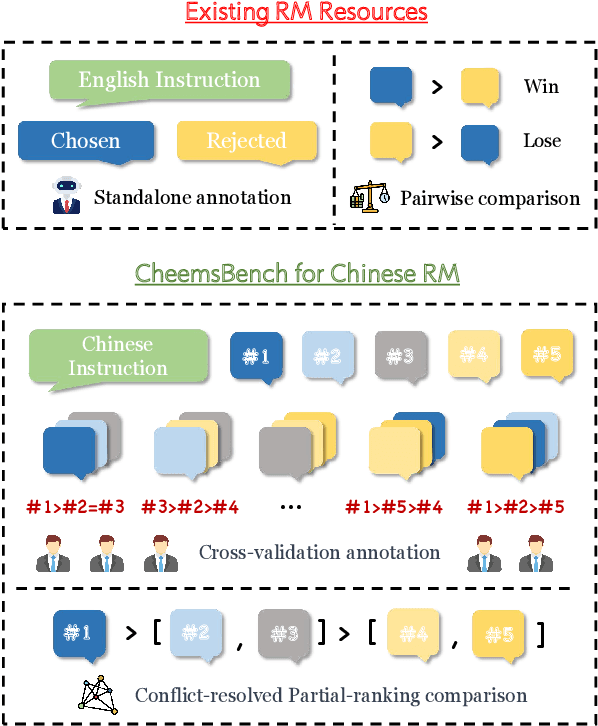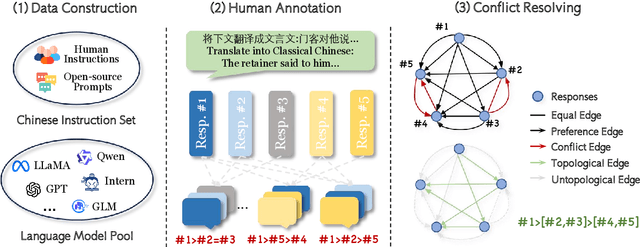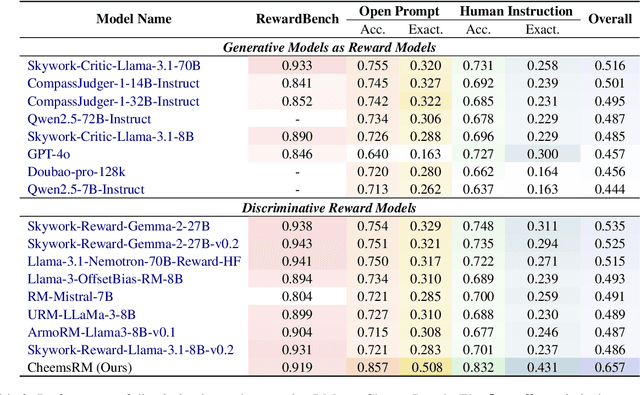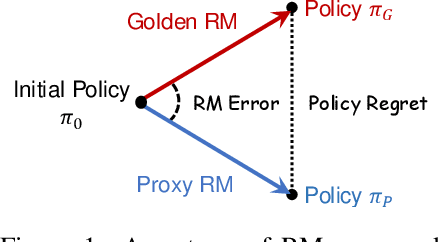Jie Lou
dots.llm1 Technical Report
Jun 06, 2025Abstract:Mixture of Experts (MoE) models have emerged as a promising paradigm for scaling language models efficiently by activating only a subset of parameters for each input token. In this report, we present dots.llm1, a large-scale MoE model that activates 14B parameters out of a total of 142B parameters, delivering performance on par with state-of-the-art models while reducing training and inference costs. Leveraging our meticulously crafted and efficient data processing pipeline, dots.llm1 achieves performance comparable to Qwen2.5-72B after pretraining on 11.2T high-quality tokens and post-training to fully unlock its capabilities. Notably, no synthetic data is used during pretraining. To foster further research, we open-source intermediate training checkpoints at every one trillion tokens, providing valuable insights into the learning dynamics of large language models.
Exploring Implicit Visual Misunderstandings in Multimodal Large Language Models through Attention Analysis
May 15, 2025Abstract:Recent advancements have enhanced the capability of Multimodal Large Language Models (MLLMs) to comprehend multi-image information. However, existing benchmarks primarily evaluate answer correctness, overlooking whether models genuinely comprehend the visual input. To address this, we define implicit visual misunderstanding (IVM), where MLLMs provide correct answers without fully comprehending the visual input. Through our analysis, we decouple the visual and textual modalities within the causal attention module, revealing that attention distribution increasingly converges on the image associated with the correct answer as the network layers deepen. This insight leads to the introduction of a scale-agnostic metric, \textit{attention accuracy}, and a novel benchmark for quantifying IVMs. Attention accuracy directly evaluates the model's visual understanding via internal mechanisms, remaining robust to positional biases for more reliable assessments. Furthermore, we extend our approach to finer granularities and demonstrate its effectiveness in unimodal scenarios, underscoring its versatility and generalizability.
MLLM-Selector: Necessity and Diversity-driven High-Value Data Selection for Enhanced Visual Instruction Tuning
Mar 26, 2025Abstract:Visual instruction tuning (VIT) has emerged as a crucial technique for enabling multi-modal large language models (MLLMs) to follow user instructions adeptly. Yet, a significant gap persists in understanding the attributes of high-quality instruction tuning data and frameworks for its automated selection. To address this, we introduce MLLM-Selector, an automated approach that identifies valuable data for VIT by weighing necessity and diversity. Our process starts by randomly sampling a subset from the VIT data pool to fine-tune a pretrained model, thus creating a seed model with an initial ability to follow instructions. Then, leveraging the seed model, we calculate necessity scores for each sample in the VIT data pool to identify samples pivotal for enhancing model performance. Our findings underscore the importance of mixing necessity and diversity in data choice, leading to the creation of MLLM-Selector, our methodology that fuses necessity scoring with strategic sampling for superior data refinement. Empirical results indicate that within identical experimental conditions, MLLM-Selector surpasses LLaVA-1.5 in some benchmarks with less than 1% of the data and consistently exceeds performance across all validated benchmarks when using less than 50%.
The Devil Is in the Details: Tackling Unimodal Spurious Correlations for Generalizable Multimodal Reward Models
Mar 05, 2025Abstract:Multimodal Reward Models (MM-RMs) are crucial for aligning Large Language Models (LLMs) with human preferences, particularly as LLMs increasingly interact with multimodal data. However, we find that MM-RMs trained on existing datasets often struggle to generalize to out-of-distribution data due to their reliance on unimodal spurious correlations, primarily text-only shortcuts within the training distribution, which prevents them from leveraging true multimodal reward functions. To address this, we introduce a Shortcut-aware MM-RM learning algorithm that mitigates this issue by dynamically reweighting training samples, shifting the distribution toward better multimodal understanding, and reducing dependence on unimodal spurious correlations. Our experiments demonstrate significant improvements in generalization, downstream task performance, and scalability, establishing a more robust framework for multimodal reward modeling.
Cheems: A Practical Guidance for Building and Evaluating Chinese Reward Models from Scratch
Feb 24, 2025



Abstract:Reward models (RMs) are crucial for aligning large language models (LLMs) with human preferences. However, most RM research is centered on English and relies heavily on synthetic resources, which leads to limited and less reliable datasets and benchmarks for Chinese. To address this gap, we introduce CheemsBench, a fully human-annotated RM evaluation benchmark within Chinese contexts, and CheemsPreference, a large-scale and diverse preference dataset annotated through human-machine collaboration to support Chinese RM training. We systematically evaluate open-source discriminative and generative RMs on CheemsBench and observe significant limitations in their ability to capture human preferences in Chinese scenarios. Additionally, based on CheemsPreference, we construct an RM that achieves state-of-the-art performance on CheemsBench, demonstrating the necessity of human supervision in RM training. Our findings reveal that scaled AI-generated data struggles to fully capture human preferences, emphasizing the importance of high-quality human supervision in RM development.
Scalable Oversight for Superhuman AI via Recursive Self-Critiquing
Feb 07, 2025Abstract:As AI capabilities increasingly surpass human proficiency in complex tasks, current alignment techniques including SFT and RLHF face fundamental challenges in ensuring reliable oversight. These methods rely on direct human assessment and become untenable when AI outputs exceed human cognitive thresholds. In response to this challenge, we explore two hypotheses: (1) critique of critique can be easier than critique itself, extending the widely-accepted observation that verification is easier than generation to the critique domain, as critique itself is a specialized form of generation; (2) this difficulty relationship is recursively held, suggesting that when direct evaluation is infeasible, performing high-order critiques (e.g., critique of critique of critique) offers a more tractable supervision pathway. To examine these hypotheses, we perform Human-Human, Human-AI, and AI-AI experiments across multiple tasks. Our results demonstrate encouraging evidence supporting these hypotheses and suggest that recursive self-critiquing is a promising direction for scalable oversight.
Search, Verify and Feedback: Towards Next Generation Post-training Paradigm of Foundation Models via Verifier Engineering
Nov 18, 2024



Abstract:The evolution of machine learning has increasingly prioritized the development of powerful models and more scalable supervision signals. However, the emergence of foundation models presents significant challenges in providing effective supervision signals necessary for further enhancing their capabilities. Consequently, there is an urgent need to explore novel supervision signals and technical approaches. In this paper, we propose verifier engineering, a novel post-training paradigm specifically designed for the era of foundation models. The core of verifier engineering involves leveraging a suite of automated verifiers to perform verification tasks and deliver meaningful feedback to foundation models. We systematically categorize the verifier engineering process into three essential stages: search, verify, and feedback, and provide a comprehensive review of state-of-the-art research developments within each stage. We believe that verifier engineering constitutes a fundamental pathway toward achieving Artificial General Intelligence.
Rethinking Reward Model Evaluation: Are We Barking up the Wrong Tree?
Oct 08, 2024



Abstract:Reward Models (RMs) are crucial for aligning language models with human preferences. Currently, the evaluation of RMs depends on measuring accuracy against a validation set of manually annotated preference data. Although this method is straightforward and widely adopted, the relationship between RM accuracy and downstream policy performance remains under-explored. In this work, we conduct experiments in a synthetic setting to investigate how differences in RM measured by accuracy translate into gaps in optimized policy performance. Our findings reveal that while there is a weak positive correlation between accuracy and downstream performance, policies optimized towards RMs with similar accuracy can exhibit quite different performance. Moreover, we discover that the way of measuring accuracy significantly impacts its ability to predict the final policy performance. Through the lens of Regressional Goodhart's effect, we identify the existence of exogenous variables impacting the relationship between RM quality measured by accuracy and policy model capability. This underscores the inadequacy of relying solely on accuracy to reflect their impact on policy optimization.
Critic-CoT: Boosting the reasoning abilities of large language model via Chain-of-thoughts Critic
Aug 29, 2024Abstract:Self-critic has become an important mechanism for enhancing the reasoning performance of LLMs. However, current approaches mainly involve basic prompts without further training, which tend to be over-simplified, leading to limited accuracy.Moreover, there is a lack of in-depth investigation of the relationship between LLM's ability to criticism and its task-solving performance.To address these issues, we propose Critic-CoT, a novel framework that pushes LLMs toward System-2-like critic capability, via step-wise CoT reasoning format and distant-supervision data construction, without the need for human annotation. Experiments on GSM8K and MATH show that via filtering out invalid solutions or iterative refinement, our enhanced model boosts task-solving performance, which demonstrates the effectiveness of our method. Further, we find that training on critique and refinement alone improves the generation. We hope our work could shed light on future research on improving the reasoning and critic ability of LLMs.
Learning In-context Learning for Named Entity Recognition
May 26, 2023Abstract:Named entity recognition in real-world applications suffers from the diversity of entity types, the emergence of new entity types, and the lack of high-quality annotations. To address the above problems, this paper proposes an in-context learning-based NER approach, which can effectively inject in-context NER ability into PLMs and recognize entities of novel types on-the-fly using only a few demonstrative instances. Specifically, we model PLMs as a meta-function $\mathcal{ \lambda_ {\text{instruction, demonstrations, text}}. M}$, and a new entity extractor can be implicitly constructed by applying new instruction and demonstrations to PLMs, i.e., $\mathcal{ (\lambda . M) }$(instruction, demonstrations) $\to$ $\mathcal{F}$ where $\mathcal{F}$ will be a new entity extractor, i.e., $\mathcal{F}$: text $\to$ entities. To inject the above in-context NER ability into PLMs, we propose a meta-function pre-training algorithm, which pre-trains PLMs by comparing the (instruction, demonstration)-initialized extractor with a surrogate golden extractor. Experimental results on 4 few-shot NER datasets show that our method can effectively inject in-context NER ability into PLMs and significantly outperforms the PLMs+fine-tuning counterparts.
 Add to Chrome
Add to Chrome Add to Firefox
Add to Firefox Add to Edge
Add to Edge